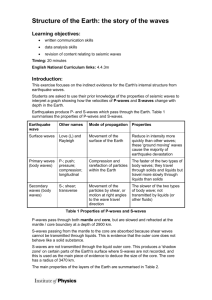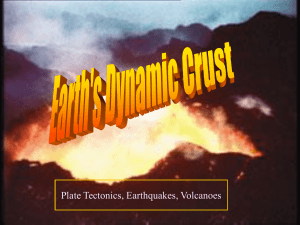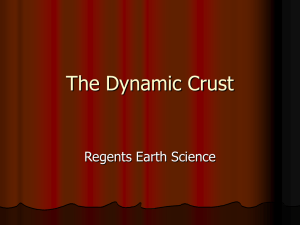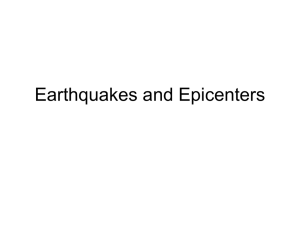Earth: Basic structure
advertisement
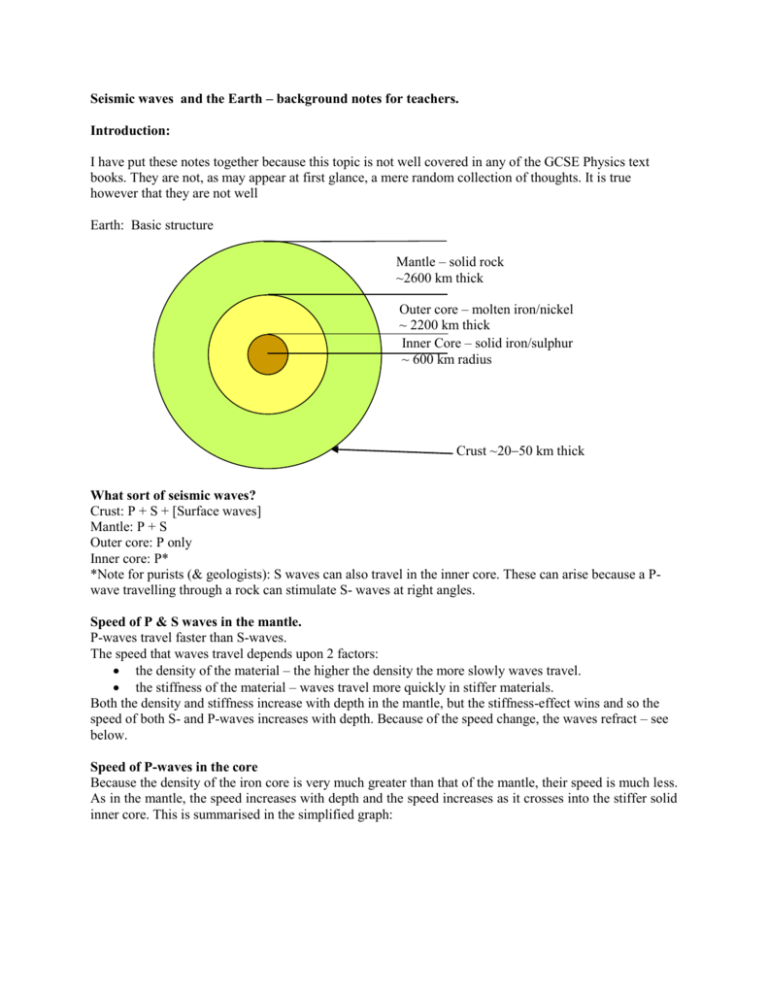
Seismic waves and the Earth – background notes for teachers. Introduction: I have put these notes together because this topic is not well covered in any of the GCSE Physics text books. They are not, as may appear at first glance, a mere random collection of thoughts. It is true however that they are not well Earth: Basic structure Mantle – solid rock ~2600 km thick Outer core – molten iron/nickel ~ 2200 km thick Inner Core – solid iron/sulphur ~ 600 km radius Crust ~2050 km thick What sort of seismic waves? Crust: P + S + [Surface waves] Mantle: P + S Outer core: P only Inner core: P* *Note for purists (& geologists): S waves can also travel in the inner core. These can arise because a Pwave travelling through a rock can stimulate S- waves at right angles. Speed of P & S waves in the mantle. P-waves travel faster than S-waves. The speed that waves travel depends upon 2 factors: the density of the material – the higher the density the more slowly waves travel. the stiffness of the material – waves travel more quickly in stiffer materials. Both the density and stiffness increase with depth in the mantle, but the stiffness-effect wins and so the speed of both S- and P-waves increases with depth. Because of the speed change, the waves refract – see below. Speed of P-waves in the core Because the density of the iron core is very much greater than that of the mantle, their speed is much less. As in the mantle, the speed increases with depth and the speed increases as it crosses into the stiffer solid inner core. This is summarised in the simplified graph: speed / km/s 15 OUTER CORE MANTLE INNER CORE P-waves 10 S-waves 5 0 0 1000 2000 3000 4000 5000 6000 Depth / km Evidence for the Internal Structure of the Earth Suppose an Earthquake happens in the Earth’s crust at A. P-waves received No S-waves Seismometers all around the world detect the waves but not all of them receive S-waves. In fact at distances of more that 105 from the earthquake focus, no S-waves are received. B What can explain this? 105 Remember that S-waves cannot travel through liquids? So there must be a liquid core in the Earth. P- & S-waves P- & S-waves We can get an estimate of the size of the liquid core by drawing a scale diagram: A How to estimate the size of the core of the Earth: 1 Draw a circle to represent the Earth: suggested scale 1 cm = 1000 km; the earth has a radius of 6400 km so make the radius of the circle 64 cm. 2 Mark a point on the surface of the Earth – label it A. 3 Draw a line from A to the centre of the Earth. 4 Draw another radius at an angle of 105 – as in the diagram above – and label point P. 5 Draw a line between A and P – this shows how the S-waves can travel from A to P. 6 Draw the biggest circle you can, with its centre at the centre of the Earth, so that that the S-waves line just misses this circle. 7 Measure the radius of this circle – the core – and use the scale to calculate the core’s radius. Refraction in the Earth. The problem with the above technique for estimating the size of the Earth’s core is that it gives the wrong answer! Why? Because it assumes that the S-waves travel in straight lines. This is wrong. By carefully measuring the travel times of the waves, geo-physicists have demonstrated that they travel in curves. Refraction in the Mantle Over a few hundred km refraction has the following effect – ignoring the curvature of the Earth: F = earthquake focus; S = Seismometer S F increasing speed with depth Path of the Earthquake waves The waves curve because the bottom edge travels faster than the top edge and so it overtakes the top edge. This makes it bend upwards. Note that both P- and S-waves curve like this. They both travel faster the deeper they go into the mantle. Key Path of P & S waves A 105 Use this idea to get a better answer for the size of the Earth’s core. Don’t make the waves too curved. What happens when the seismic waves pass from the mantle into the core? Two things: 1 The S-waves get absorbed (or possible reflected – but we’ll ignore this!). 2 Looking at the graph, we see that the P-waves slow down from ~13 km/s to ~8km/s. This is similar in proportion to when light waves go from air into glass – and the effect is the same. So the P-waves bend towards the normal. The reason they travel more slowly in the core is that, consisting of a nickel/iron mixture, the core is much denser than the silicate-rock mantle and there is not much difference in the stiffness. Remember the diagram – this is the same as a ripple-tank diagram. In the ripple tank, the lower part of the diagram would be “shallow water” and the top would be “deep water.” Mantle Core Inside the core The waves bend at the core-mantle boundary because they slow down. Inside the core, the waves curve gradually, just like in the mantle, because the deeper they get, the faster they become – because the core is stiffer at greater depths. They don’t bend very much though because the speed doesn’t change very much – see the graph. If the waves pass through the inner core, they refract again. They also refract as they pass back into the mantle. A couple of drawings in case I need them again. It’s pretty obvious what the lower one was for, but the ellipse???:
